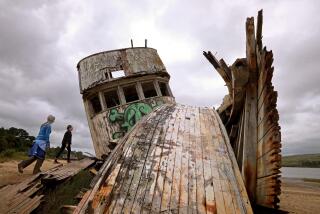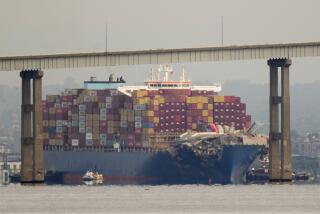New shipwreck off Taiwan is a must-see for many tourists
- Share via
reporting from SHIMEN TOWNSHIP, Taiwan — It was a terrifying scene: Last month, a massive container ship lost power in a storm shortly after leaving port in Taiwan and ran into a reef, splitting the ship in half.
After helicopters rescued the 21 crew members, the ship’s fuel began leaking into a national scenic area, raising the specter of environmental disaster.
But the wreck of the T.S. Taipei is gaining fame not just as a catastrophe, but as Taiwan’s hottest new tourist attraction.
Hundreds, possibly thousands, of people are pulling up in cars and motor scooters every day along a highway that hugs Taiwan’s touristy north coast for a look at the T.S. Lines freighter that’s stranded in plain view from the shore.
Take Lee Hong-rong. The 70-year-old has made the same hourlong drive three times just to gawk from the side of a highway.
“I’m retired and kind of bored,” Lee said as he switched between staring and flipping through his phone for photos of previous visits. “People like me have never seen this kind of thing, a full-blown ship that’s broken apart. And they can’t move it.”
The disaster’s environmental impact is real — since it hit the rocks March 10 it has created an eight-mile oil slick, contaminating a shoreline that normally brings out day trippers with its natural scenery.
About 200 government-organized workers, some in white protective suits, gather daily to help clean up as the central government’s radars, satellite technology and unmanned aerial vehicles analyze the spread of leaked fuel and heavy oil.
“Most of the viewers are from other places, like southern Taiwan,” said Chiang Hsiu-yu, a roadside food vendor along the highway. Visitors swamp her stall on weekends especially. “Some will snap a few photos and go while others stay around longer.”
The Taiwanese coastline is no stranger to shipwrecks. People in the coastal hamlet of Shimen, where the crowds have gathered, remember another one in the same place about eight years ago. And in February, a Taiwanese-registered cargo and passenger ship ran aground in the Taiwan Strait when it lost power on its way from China to Indonesia.
But the wreck of the 551-foot T.S. Taipei has grabbed attention because it sits less than 300 yards from a coastal scenic area that logged 6.48 million visits last year. Any pair of eyes can see the fracture line that has cut the bent ship in half from top to bottom.
“I saw this on television,” said 60-year-old Lai Hsiu-wa, who sat staring from a parked van after driving from the next county. “How could it have wrecked so close to the shore?”
Another carload of people had stopped in front of Lai’s vehicle on the same weekday morning, blocking part of a traffic lane. As that one pulled out, two more came in from behind. A pack of scooters was parked a few yards away, some of their riders spread out along the highway shoulder with cameras. Across the street a man stared from a balcony.
Although government officials guess that most of the oil — a total of 536 gallons as of Thursday — has been captured, Taiwan’s Maritime & Port Bureau says an unknown amount remains trapped under the wreckage. Beaches and offshore rocks have been cleared of oil.
Every day that weather permits, workers from Taiwan’s Environmental Protection Administration try to find more. Officials from the Taipei-based shipping line said they are helping with the cleanup but declined further comment.
The ship is set to be dismantled piecemeal through mid-May, when swimming beaches open for the season. Two cafes and a handful of other eateries near the shipwreck have benefited from the constant crowds of gawkers, but the food stall operator said normal crowds visiting clean beaches will be better.
Decontamination work has already finished at a nearby harbor and three designated scenic areas along the coast. Workers also grabbed 3,210 tons of garbage as they cleared fuel.
“Tourists are curious when they see big liners at sea and they want to check it out,” said Kuo Chen-lin, secretary with the North Coast & Guanyinshan National Scenic Area, which includes Shimen Township. “But it’s not the high season yet. That will come when we open access to the water.”
Jennings is a special correspondent.
ALSO
Trump, Kasich and Cruz make their cases to California GOP
Sharpton: Larry Wilmore’s calling Obama the ‘N-word’ was in ‘bad taste’
On his Santa Monica mountaintop, a billionaire envisions lofty thoughts
More to Read
Sign up for Essential California
The most important California stories and recommendations in your inbox every morning.
You may occasionally receive promotional content from the Los Angeles Times.










